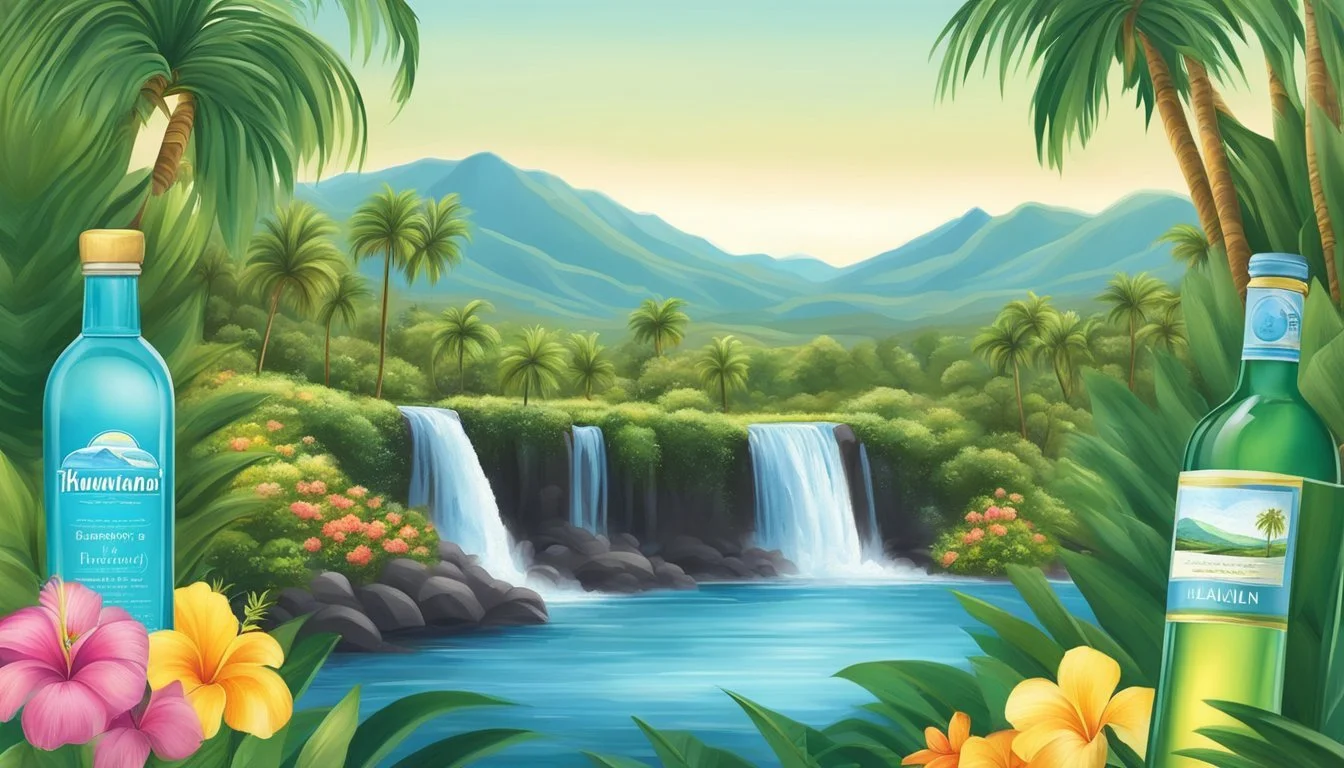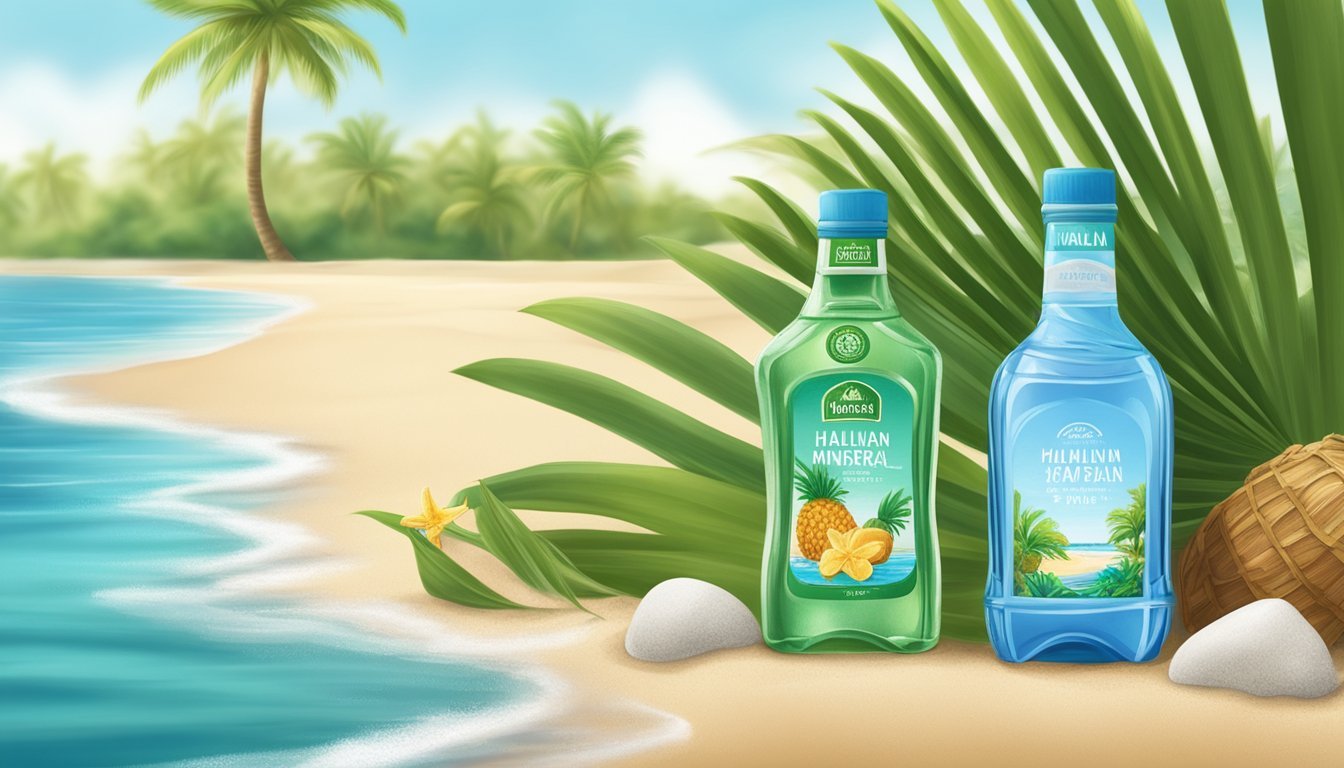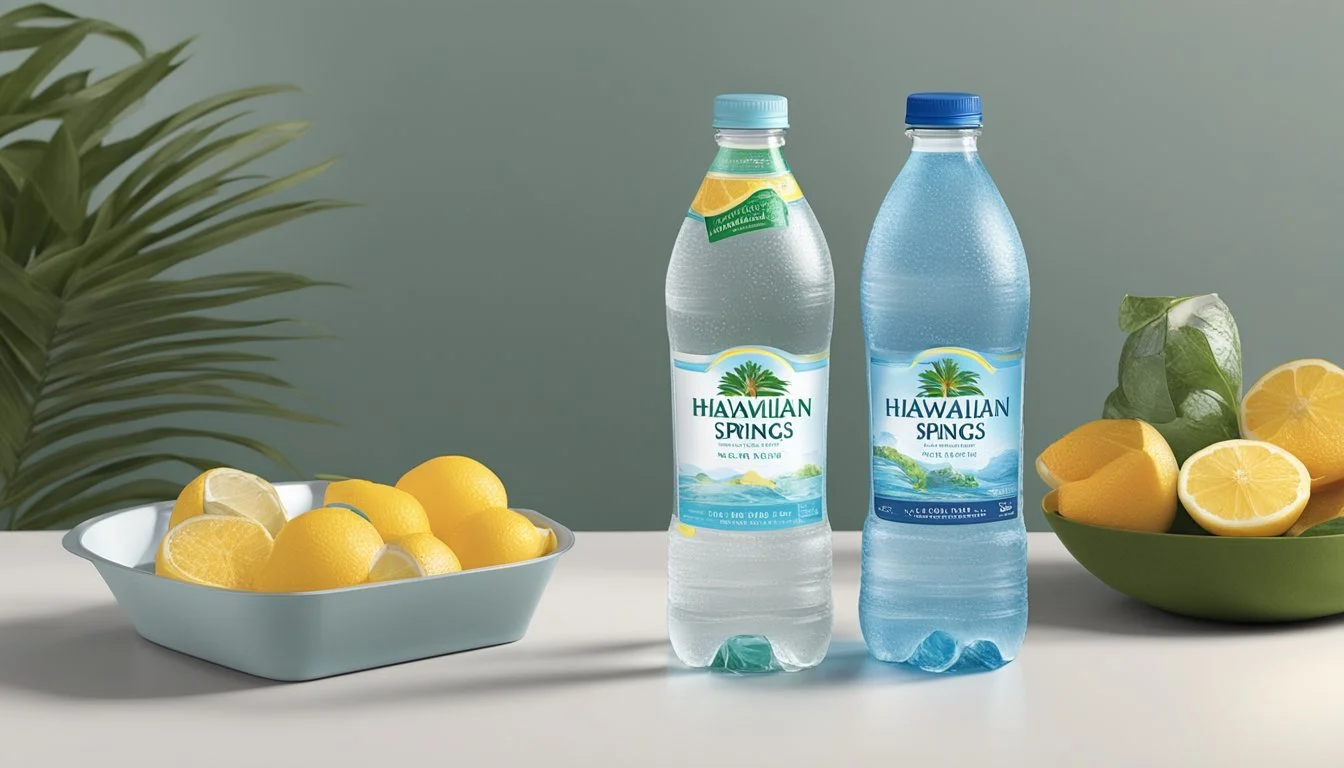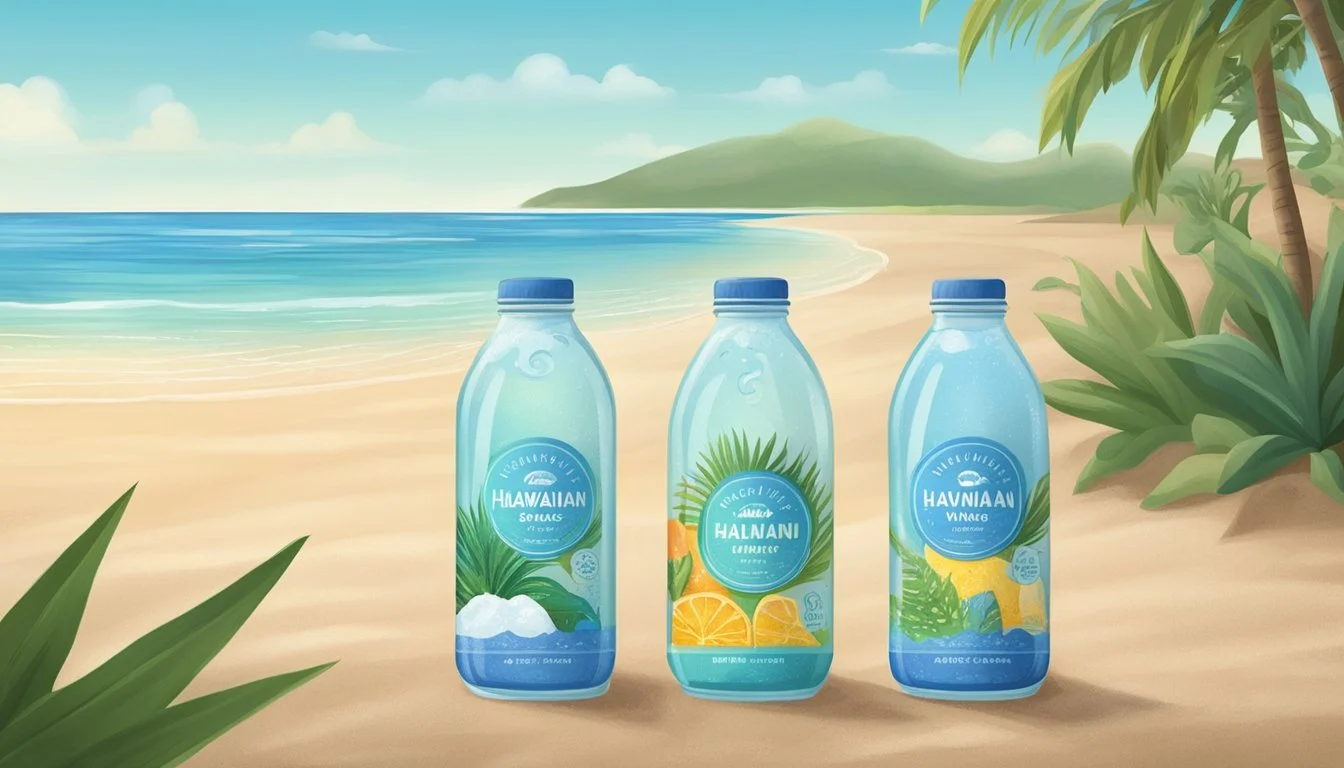Hawaiian Springs vs. Whole Foods Italian Still Mineral Water
Which Bottled Water is Better?
Choosing between Hawaiian Springs and Whole Foods Italian Still Mineral Water can be a matter of personal preference, but a few key differences might help you decide which is better for your lifestyle. Hawaiian Springs water, known for its exceptionally pure source from the Big Island of Hawaii, boasts a crisp, refreshing taste that reflects its volcanic origins. This water is naturally alkaline, contributing to hydration and overall wellness.
Whole Foods Italian Still Mineral Water, on the other hand, hails from the pristine environments of Italy's mountain springs. This water is treasured for its balanced mineral content, offering a smooth flavor profile ideal for everyday drinking and culinary use. Its focus on wellness and hydration is evident in its carefully monitored mineral composition.
Both Hawaiian Springs and Whole Foods Italian Still Mineral Water provide excellent hydration and wellness benefits, but the choice boils down to your taste preference and the specific health benefits each brand offers. Whether you crave the volcanic purity of Hawaiian Springs or the mineral-rich balance of Whole Foods Italian Still Mineral Water, either option promises a refreshing experience.
Understanding Bottled Water
Bottled water varies based on its source, treatment processes, and types. Understanding these differences helps consumers make informed choices.
Source and Origin
The source of bottled water significantly influences its taste and quality. Spring water is collected from natural springs, ensuring minimal human interference. It often maintains a balanced mineral composition, offering a fresh taste.
Mineral water also originates from natural sources, often underground springs. However, it must retain a minimum mineral content and its composition must remain unaltered. This source-related regulation helps maintain its specific mineral profile.
Tap water, though not bottled, serves as a comparison. It is generally treated municipal water and may lack the specialized qualities of spring or mineral water.
Types of Bottled Water
Bottled waters come in various types, each suited for different preferences. Spring water flows naturally to the earth’s surface and is bottled with minimal processing, ensuring its natural characteristics remain intact.
Mineral water is rich in minerals that are naturally present from its underground sources. Unlike spring water, its mineral content cannot be modified.
Still water refers to non-carbonated forms, offering a smooth and subtle drinking experience. Sparkling water, naturally or artificially carbonated, adds bubbly effervescence, appealing to those who prefer a fizzy sensation.
Comparing Spring Water and Mineral Water
Spring water and mineral water share similarities in their natural origination but differ in their properties. Spring water provides a pure and clean profile, valuable for its light taste derived directly from a natural spring without added minerals.
In contrast, mineral water contains higher quantities of dissolved solids, enhancing its taste and potential health benefits. The mineral composition includes calcium, magnesium, and potassium, prompting choices based on nutritional needs.
Natural spring water is preferred for everyday hydration, while those looking for mineral benefits lean towards mineral water. Both remain distinct in their effervescence and mineral content despite being sourced from natural springs.
Hawaiian Springs and Whole Foods Italian Still Mineral Water
Both Hawaiian Springs and Whole Foods Italian Still Mineral Water offer unique benefits and are suited to different consumer preferences. This section details the distinct characteristics and origins of each water, shedding light on important aspects such as source, taste, and packaging.
Hawaiian Springs Overview
Hawaiian Springs natural artesian water is sourced from deep aquifers within lava rock on Hawaii's Big Island.
This water is drawn from Mauna Loa's slopes, providing a unique mineral composition and a naturally alkaline pH of 7.7+.
Sustainability is key, with the water being bottled at the source in recyclable containers. The company emphasizes the renewable nature of their water sources.
Its taste profile is often described as clean and refreshing, ideal for hydration. Hawaiian Springs is positioned as a premium brand known for its pristine and unique source.
Whole Foods Italian Still Mineral Water Overview
Whole Foods Italian Still Mineral Water, Acqua Panna, is sourced from the Apennine Mountains in Tuscany, Italy.
Boasting a balanced mineral content, it is a popular choice for its smooth and velvety taste.
This water is renowned for its soft taste, making it an excellent companion to fine dining experiences.
The packaging is designed for sustainability, with a focus on recyclable materials. The water’s availability can vary, being sold exclusively through Whole Foods Market.
Acqua Panna offers excellent hydration with consistent quality, catering to consumers looking for a distinct and premium Italian water.
Health and Hydration Benefits
Both Hawaiian Springs and Whole Foods Italian Still Mineral Water offer unique health and hydration benefits due to their distinct mineral compositions and sources. Below, specific aspects of their contributions to health and hydration are examined.
Minerals and Electrolytes
Hawaiian Springs water is noted for its alkaline nature, which may help balance the body's pH levels. This water also typically contains calcium and magnesium, essential for bone health and muscle function. These electrolytes support various physiological processes, such as enzyme functions and nerve transmissions.
Whole Foods Italian Still Mineral Water, sourced from Italy, contains minerals that contribute to a refreshing drinking experience. It may be rich in calcium and magnesium, aiding in digestion and cardiovascular health. The electrolytes present are crucial for maintaining the body's balance of fluids and supporting overall wellness.
Hydration and Wellness Impacts
Proper hydration is a critical part of maintaining wellness and bodily functions. Hawaiian Springs water is praised for its refreshing flavor and ability to hydrate efficiently due to its alkalinity and mineral content. This can contribute to better skin health, digestion, and reduced fatigue.
Whole Foods Italian Still Mineral Water also promotes hydration with its balanced mineral profile. Drinking water with natural minerals can enhance electrolyte intake, improving hydration and well-being. The water's minerals may also help improve mood and cognitive function, elements essential for maintaining a healthy lifestyle.
Environmental Impact and Sustainability
Hawaiian Springs and Whole Foods Italian Still Mineral Water both strive to balance consumer demand with environmental consciousness. Each brand adopts different methods to minimize their ecological footprint.
Bottling Process and Eco-Friendly Practices
Hawaiian Springs primarily uses plastic bottles, which are lightweight and reduce transport emissions but contribute to plastic waste. They engage in eco-friendly practices by implementing recycling programs and reducing plastic usage in their packaging.
In contrast, Whole Foods’ Italian Still Mineral Water typically comes in glass bottles, ensuring recyclability and a lower environmental impact in terms of waste generation. This choice, while creating a higher carbon footprint due to heavier transportation, is considered a more sustainable option as glass is consistently recycled.
Source Conservation and Path to Sustainability
Hawaiian Springs sources water from pristine Hawaiian aquifers. They focus on source conservation by using modern extraction techniques that do not disrupt the natural flow of the ecosystem. Measures to maintain the purity of the water source are a priority, ensuring a consistent supply without environmental degradation.
Whole Foods’ Italian Still Mineral Water sources from natural springs in Italy. Their path to sustainability includes protecting the natural water source through regulated extraction practices. This allows them to provide high-quality water while preserving the integrity of the environment.
Both brands are committed to maintaining the sustainability of their sources, albeit through different methods and practices.
Quality and Safety Standards
Hawaiian Springs and Whole Foods Italian Still Mineral Water both maintain high standards of quality and safety. Monitoring for contaminants such as lead and arsenic is critical in ensuring consumer safety.
International and Local Regulations
International guidelines play a key role in setting quality and safety standards for bottled water. Entities like the International Bottled Water Association (IBWA) require strict adherence to safety measures. Both Hawaiian and Italian bottled waters must comply with these regulations.
Local laws also matter. Hawaiian Springs must meet U.S. FDA standards, while Whole Foods Italian Still Mineral Water adheres to European Union regulations. These rules oversee water sources, processing, and bottling, ensuring both brands are free from harmful contaminants like lead and arsenic.
Involvement of Investigative Journalism
Investigative journalism has been vital in uncovering issues with bottled water safety. Consumer Reports, for instance, has highlighted contaminants in bottled water, driving improvements.
Reports found certain brands containing harmful substances such as PFAS chemicals and arsenic. Such findings push brands including Hawaiian Springs and Whole Foods to maintain rigorous quality controls. Investigations bring transparency, reassuring consumers about the safety of the water they drink.
Flavor and Palate Preferences
Hawaiian Springs and Whole Foods Italian Still Mineral Water offer unique flavor profiles appealing to different palates. Exploring the distinct characteristics and the influence of water sommeliers can help uncover the subtleties that make each brand stand out.
Unique Flavor Profiles
Hawaiian Springs water is sourced from a tropical rainforest in Hawaii. It has a light, refreshing taste with a subtle sweetness, making it ideal for those who prefer a clean and mellow flavor.
In contrast, Whole Foods Italian Still Mineral Water boasts a distinct mineral richness. Its flavor is slightly more robust due to the natural minerals present in the Italian Alps springs where it's sourced. These nuances provide a more complex taste experience.
Additionally, while Hawaiian Springs is renowned for its smooth texture, the Whole Foods variant has a slight effervescence that can add to its refreshing quality. Each water’s unique flavor profile is influenced by its mineral content and source, catering to different palate preferences.
The Role of a Water Sommelier
A water sommelier plays a crucial role in evaluating these waters. They assess the taste, texture, and effervescence, providing insights into the qualities that set them apart. Their expertise helps in understanding the subtle differences between Hawaiian Springs' lighter profile and Whole Foods' mineral-rich taste.
These professionals can identify the nuances in mouthfeel and aftertaste, offering recommendations aligned with individual preferences. They emphasize the importance of mineral balance and natural purity, which are key to appreciating the refreshing flavors of both waters.
By evaluating each water’s unique characteristics, a water sommelier highlights the elegance and quality found in both Hawaiian Springs and Whole Foods Italian Still Mineral Water, aiding consumers in making an informed choice.
Consumer Insights
Insights into consumer behavior reveal important trends regarding preferences, market share, and the balance between quality and price in bottled water brands.
Brand Loyalty and Market Trends
Brand loyalty plays a significant role in the bottled water market. Hawaiian Springs and Whole Foods Italian Still Mineral Water cater to different demographics. Hawaiian Springs is popular for its clear, crisp taste and is often associated with luxury. On the other hand, Whole Foods leverages its reputation for high-quality, organic products to attract health-conscious consumers.
Market share varies, with brands like Voss and Core Hydration also competing in the premium segment. Grocery stores frequently stock Whole Foods water due to its robust supply chain. Italian water brands still capture a niche market, appealing to those seeking a touch of European quality.
Quality vs. Price Considerations
Consumers often weigh quality against price when choosing bottled water. Hawaiian Springs is priced higher, reflecting its premium status and the perceived purity of Hawaiian sources. This attracts consumers willing to pay more for a sense of exclusivity and better taste.
Whole Foods Italian Still Mineral Water offers a balance between quality and affordability. It meets stringent safety regulations and provides a mineral-rich taste, making it a solid choice for those prioritizing both health and budget. This positioning helps Whole Foods maintain a strong presence in the competitive bottled water market, alongside luxury and everyday brands.
Comparative Analysis
Whole Foods Italian Still Mineral Water and Hawaiian Springs offer differing benefits in terms of nutrient content, environmental impact, price, and taste. Each aspect will help determine which bottled water may be more suitable for consumers.
Nutrient Content and Health Benefits
Whole Foods Italian Still Mineral Water is known for its rich mineral composition including calcium, magnesium, and bicarbonates. These minerals support bone health and hydration. Hawaiian Springs, sourced from Hawaiian aquifers, is naturally alkaline with a pH level around 7.7-8.2. Alkaline water offers potential health benefits like neutralizing stomach acid and improving metabolism.
Consumers may prefer Whole Foods Italian Still Mineral Water for its essential minerals. However, Hawaiian Springs' alkalinity can be appealing for those needing to balance their body's pH levels.
Environmental Impact and Ethics
Sustainability and ethical practices are crucial in evaluating bottled water. Whole Foods emphasizes eco-friendly practices, including recyclable packaging and reduced plastic usage. It collaborates with environmentally responsible suppliers, aiming to minimize its carbon footprint.
Hawaiian Springs also engages in sustainable practices. The company focuses on protecting Hawaii's natural resources by adhering to strict environmental guidelines. Both brands are committed to eco-friendliness, but Whole Foods' broader environmental initiatives might be more recognizable to the average consumer.
Price and Accessibility
Price and availability vary between the two brands. Whole Foods Italian Still Mineral Water is predominantly sold in Whole Foods stores and online, making it accessible to those who shop there. Its price point is often higher due to the brand's premium positioning.
Hawaiian Springs is available in multiple grocery stores and online retailers, which enhances its accessibility. It typically has a mid-range price point, making it more budget-friendly compared to Whole Foods' offering. Consumers on a budget may find Hawaiian Springs the better option without sacrificing quality.
Taste Test and Personal Preferences
Taste is a significant factor in choosing bottled water. Whole Foods Italian Still Mineral Water is renowned for its clean and crisp taste with subtle mineral notes. It's often praised by water sommeliers for its refreshing flavor, making it a favorite among connoisseurs.
Hawaiian Springs offers a unique flavor profile attributed to its volcanic origins. It's described as exceptionally smooth with a slightly sweet finish. Those preferring a lighter, more delicate taste might lean towards Hawaiian Springs, while others may favor the robust mineral notes of Whole Foods Italian Still Mineral Water.
More About Hawaiian Springs
Acqua Pana vs Hawaiian Springs: Which Bottled Water is Better?
Aqua Carpatica vs Hawaiian Springs: Which Bottled Water is Better?
Aquafina vs Hawaiian Springs: Which Bottled Water is Better?
Arrowhead vs Hawaiian Springs: Which Bottled Water is Better?
Boxed Water vs Hawaiian Springs: Which Bottled Water is Better?
Castle Rock vs Hawaiian Springs: Which Bottled Water is Better?
Core Hydration vs Hawaiian Springs: Which Bottled Water is Better?
Deer Park vs Hawaiian Springs: Which Bottled Water is Better?
Essentia vs Hawaiian Springs: Which Bottled Water is Better?
Hawaiian Springs vs 1907water: Which Bottled Water is Better?
Hawaiian Springs vs 7-Select: Which Bottled Water is Better?
Hawaiian Springs vs Alkaline88: Which Bottled Water is Better?
Hawaiian Springs vs Antipodes: Which Bottled Water is Better?
Hawaiian Springs vs Big Chill: Which Bottled Water is Better?
Hawaiian Springs vs BodyArmor: Which Bottled Water is Better?
Hawaiian Springs vs Cascade Mountain: Which Bottled Water is Better?
Hawaiian Springs vs CBD Living: Which Bottled Water is Better?
Hawaiian Springs vs Crystal Geyser: Which Bottled Water is Better?
Hawaiian Springs vs Crystal Lake: Which Bottled Water is Better?
Hawaiian Springs vs Essence pH10: Which Bottled Water is Better?
Hawaiian Springs vs Hawaii Volcanic: Which Bottled Water is Better?
Hawaiian Springs vs Kirkland Signature: Which Bottled Water is Better?
Hawaiian Springs vs Liquid Death: Which Bottled Water is Better?
Hawaiian Springs vs Mananalu: Which Bottled Water is Better?
Hawaiian Springs vs Open Water: Which Bottled Water is Better?
Hawaiian Springs vs Proud Source: Which Bottled Water is Better?
Hawaiian Springs vs Pure Life: Which Bottled Water is Better?
Hawaiian Springs vs Purely Sedona: Which Bottled Water is Better?
Hawaiian Springs vs Refreshe: Which Bottled Water is Better?
Hawaiian Springs vs Richard's Rainwater: Which Bottled Water is Better?
Hawaiian Springs vs Simple Truth: Which Bottled Water is Better?
Hawaiian Springs vs Solan de Cabras: Which Bottled Water is Better?
Hawaiian Springs vs Talking Rain AQA: Which Bottled Water is Better?
Hawaiian Springs vs The Well: Which Bottled Water is Better?
Hawaiian Springs vs Tru Alka: Which Bottled Water is Better?
Hawaiian Springs vs Weird Water: Which Bottled Water is Better?
Hawaiian Springs vs Whole Foods 365: Which Bottled Water is Better?
Ice Mountain vs Hawaiian Springs: Which Bottled Water is Better?
Icelandic Glacial vs Hawaiian Springs: Which Bottled Water is Better?
Just Water vs Hawaiian Springs: Which Bottled Water is Better?
Mountain Valley Spring Water vs Hawaiian Springs: Which Bottled Water is Better?
Nestle Pure Life vs Hawaiian Springs: Which Bottled Water is Better?
Poland Spring vs Hawaiian Springs: Which Bottled Water is Better?
San Pellegrino vs Hawaiian Springs: Which Bottled Water is Better?
Smartwater vs Hawaiian Springs: Which Bottled Water is Better?
Topo Chico vs Hawaiian Springs: Which Bottled Water is Better?
Zephyrhills vs Hawaiian Springs: Which Bottled Water is Better?
More About Whole Foods Italian Still Mineral Water
Whole Foods Italian Still Mineral water vs HFactor: Which Bottled Water is Better?
Acqua Pana vs Whole Foods Italian Still Mineral water: Which Bottled Water is Better?
Antipodes vs Whole Foods Italian Still Mineral water: Which Bottled Water is Better?
Aqua Carpatica vs Whole Foods Italian Still Mineral water: Which Bottled Water is Better?
Aquafina vs Whole Foods Italian Still Mineral water: Which Bottled Water is Better?
Arrowhead vs Whole Foods Italian Still Mineral water: Which Bottled Water is Better?
Bai vs Whole Foods Italian Still Mineral water: Which Bottled Water is Better?
Boxed Water vs Whole Foods Italian Still Mineral water: Which Bottled Water is Better?
Castle Rock vs Whole Foods Italian Still Mineral water: Which Bottled Water is Better?
Core Hydration vs Whole Foods Italian Still Mineral water: Which Bottled Water is Better?
Deer Park vs Whole Foods Italian Still Mineral water: Which Bottled Water is Better?
Erewhon vs Whole Foods Italian Still Mineral water: Which Bottled Water is Better?
Essentia vs Whole Foods Italian Still Mineral water: Which Bottled Water is Better?
Eternal vs Whole Foods Italian Still Mineral water: Which Bottled Water is Better?
Ethos vs Whole Foods Italian Still Mineral water: Which Bottled Water is Better?
Evian vs Whole Foods Italian Still Mineral water: Which Bottled Water is Better?
Fiji vs Whole Foods Italian Still Mineral water: Which Bottled Water is Better?
Flow vs Whole Foods Italian Still Mineral water: Which Bottled Water is Better?
Hawaii Volcanic vs Whole Foods Italian Still Mineral water: Which Bottled Water is Better?
Ice Mountain vs Whole Foods Italian Still Mineral water: Which Bottled Water is Better?
Icelandic Glacial vs Whole Foods Italian Still Mineral water: Which Bottled Water is Better?
Just Water vs Whole Foods Italian Still Mineral water: Which Bottled Water is Better?
LIFEWTR vs Whole Foods Italian Still Mineral water: Which Bottled Water is Better?
Liquid Death vs Whole Foods Italian Still Mineral water: Which Bottled Water is Better?
Mananalu vs Whole Foods Italian Still Mineral water: Which Bottled Water is Better?
Nestle Pure Life vs Whole Foods Italian Still Mineral water: Which Bottled Water is Better?
Origin vs Whole Foods Italian Still Mineral water: Which Bottled Water is Better?
Ozarka vs Whole Foods Italian Still Mineral water: Which Bottled Water is Better?
Path vs Whole Foods Italian Still Mineral water: Which Bottled Water is Better?
Penta vs Whole Foods Italian Still Mineral water: Which Bottled Water is Better?
Perrier vs Whole Foods Italian Still Mineral water: Which Bottled Water is Better?
Poland Spring vs Whole Foods Italian Still Mineral water: Which Bottled Water is Better?
Purely Sedona vs Whole Foods Italian Still Mineral water: Which Bottled Water is Better?
San Pellegrino vs Whole Foods Italian Still Mineral water: Which Bottled Water is Better?
Smartwater vs Whole Foods Italian Still Mineral water: Which Bottled Water is Better?
Solan de Cabras vs Whole Foods Italian Still Mineral water: Which Bottled Water is Better?
Starkey vs Whole Foods Italian Still Mineral water: Which Bottled Water is Better?
Tahoe vs Whole Foods Italian Still Mineral water: Which Bottled Water is Better?
Topo Chico vs Whole Foods Italian Still Mineral water: Which Bottled Water is Better?
Tru Alka vs Whole Foods Italian Still Mineral water: Which Bottled Water is Better?
Volvic vs Whole Foods Italian Still Mineral water: Which Bottled Water is Better?
Voss vs Whole Foods Italian Still Mineral water: Which Bottled Water is Better?
Waiakea vs Whole Foods Italian Still Mineral water: Which Bottled Water is Better?
Whole Foods Italian Still Mineral water vs 1907water: Which Bottled Water is Better?
Whole Foods Italian Still Mineral water vs 7-Select: Which Bottled Water is Better?
Whole Foods Italian Still Mineral water vs Action: Which Bottled Water is Better?
Whole Foods Italian Still Mineral water vs Alkaline88: Which Bottled Water is Better?
Whole Foods Italian Still Mineral water vs Augi: Which Bottled Water is Better?
Whole Foods Italian Still Mineral water vs Big Chill: Which Bottled Water is Better?
Whole Foods Italian Still Mineral water vs Big Win: Which Bottled Water is Better?
Whole Foods Italian Still Mineral water vs Blk: Which Bottled Water is Better?
Whole Foods Italian Still Mineral water vs BodyArmor: Which Bottled Water is Better?
Whole Foods Italian Still Mineral water vs Cascade Mountain: Which Bottled Water is Better?
Whole Foods Italian Still Mineral water vs CBD Living: Which Bottled Water is Better?
Whole Foods Italian Still Mineral water vs Cirro: Which Bottled Water is Better?
Whole Foods Italian Still Mineral water vs Crystal Geyser: Which Bottled Water is Better?
Whole Foods Italian Still Mineral water vs Crystal Lake: Which Bottled Water is Better?
Whole Foods Italian Still Mineral water vs Dasani: Which Bottled Water is Better?
Whole Foods Italian Still Mineral water vs Defy: Which Bottled Water is Better?
Whole Foods Italian Still Mineral water vs Essence pH10: Which Bottled Water is Better?
Whole Foods Italian Still Mineral water vs Kirkland Signature: Which Bottled Water is Better?
Whole Foods Italian Still Mineral water vs Kroger: Which Bottled Water is Better?
Whole Foods Italian Still Mineral water vs Open Water: Which Bottled Water is Better?
Whole Foods Italian Still Mineral water vs Ophora: Which Bottled Water is Better?
Whole Foods Italian Still Mineral water vs Proud Source: Which Bottled Water is Better?
Whole Foods Italian Still Mineral water vs Pure Life: Which Bottled Water is Better?
Whole Foods Italian Still Mineral water vs Ramona: Which Bottled Water is Better?
Whole Foods Italian Still Mineral water vs Refreshe: Which Bottled Water is Better?
Whole Foods Italian Still Mineral water vs Richard's Rainwater: Which Bottled Water is Better?
Whole Foods Italian Still Mineral water vs Simple Truth: Which Bottled Water is Better?
Whole Foods Italian Still Mineral water vs Skyra: Which Bottled Water is Better?
Whole Foods Italian Still Mineral water vs Talking Rain AQA: Which Bottled Water is Better?
Whole Foods Italian Still Mineral water vs The Well: Which Bottled Water is Better?
Whole Foods Italian Still Mineral water vs Weird Water: Which Bottled Water is Better?
Whole Foods Italian Still Mineral water vs Whole Foods 365: Which Bottled Water is Better?
Whole Foods Italian Still Mineral water vs Zenwtr: Which Bottled Water is Better?
Zephyrhills vs Whole Foods Italian Still Mineral water: Which Bottled Water is Better?








